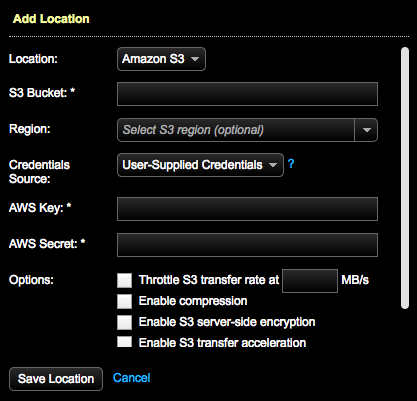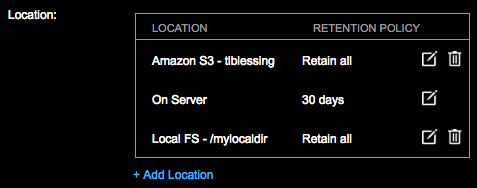Adding an Amazon S3 backup location
Add an Amazon S3 backup location. Set a retention policy for the backup location.
Add an Amazon S3 backup location. For more details, see backing up to Amazon S3 and the Amazon S3 transfer acceleration documentation.
Prerequisites
- Java 8 is required to store at an S3 location.
- Make sure you have the proper AWS IAM privileges.
- An S3 bucket destination must be unique and self-contained. Any defined destination cannot be contained within another backup destination. For example, if you set up a backup location to mybucket1, do not designate another backup location to mybucket1/myfolder1. If you set up a mybucket1/myfolder1 location, do not set up another location as mybucket1/myfolder1/mysubfolder1. Folders are supported; however, bucket paths cannot share any portion of a backup destination.
- As a recommended best practice, limit an S3 bucket to a single keyspace for
OpsCenter backups. Because every backup job gathers a list of all existing data
files before the transfer to S3 can start, that process can take more time as
the number of files grow in the bucket.Important: Moving backup files from Amazon S3 to Amazon Glacier is not supported by the OpsCenter Backup Service.
Procedure
-
Access the Create (or Edit) Backup dialog:
- Click .
- Click the Details link for the Backup Service.
- In the Activity tab, click Create Backup.
-
In the Create or Edit Backup dialog, under Location, click
+Add Location.
The Add Location dialog appears.

- Select Amazon S3 as the backup Location.
-
Enter the S3 Bucket name.
Note: The bucket name must be at least 4 characters long. Bucket names should only contain lowercase letters, numbers, and hyphens. Additionally, OpsCenter requires that bucket prefixes contain only lowercase letters, numbers, and safe characters. See the S3 guidelines for more details about bucket naming restrictions.Tip: To indicate a bucket subfolder location, delineate the bucket name from the folder name with a forward slash (/) character. Example: mybucket/myfolder/mysubfolder. Remember that slashes are not allowed within bucket or folder names themselves.
-
Select the source type of your AWS credentials.
Warning: The AWS credentials and bucket names are stored in cluster_name.conf (with the exception of ad hoc backups). Be sure to use proper security precautions to ensure that this file is not readable by unauthorized users.
Option Description User-Supplied Credentials Enter your AWS key and AWS Secret. See AWS Access Keys. AWS Credential Provider chain Use the default credential provider chain to locate AWS credentials. See Working with AWS Credentials. - Optional:
Select any throttling, compressing, or encryption of the data:
- Optional:
For scheduled backups, indicate how long the snapshot data
should be retained by selecting a Retention
Policy. Retain All (default) saves the
snapshot data indefinitely. Or, define a set period of time. After the snapshot
data is older than the time set in Retention Policy, the snapshot data is
deleted.
DataStax strongly recommends setting a retention policy to periodically remove backups. This practice helps to avoid long-term performance issues caused by an excessive number of backups.
Note: Setting a Retention Policy is not available for an ad hoc (Run Now) backup. -
Click Save Location.
The newly added S3 location displays in the Location pane of the Create or Edit Backup dialog.

Click the edit icon to the edit a location and its retention policy if applicable. Click the delete icon to delete a location. The On Server location cannot be deleted.
- Click Save Backup, or Create Backup as applicable.
